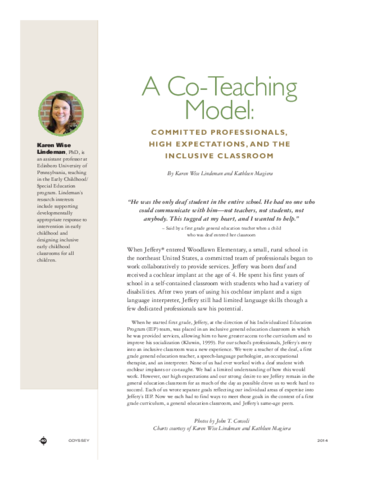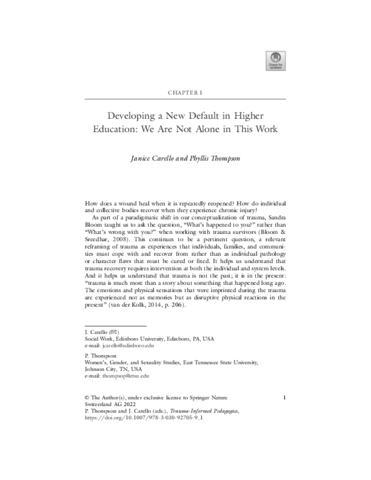Title
Displaying results 1 - 23 of 23
Childhood Autobiographical Memory Loss in Adult Survivors of Child Sexual Abuse
Author: Wolf, Molly R.
Institution: Edinboro University of Pennsylvania
Department: Department of Social Work
Author: Nochajski, Thomas H.
Institution: State University of New York at Buffalo
Department: Buffalo Center for Social Research
2022
Contributor (ctb): Lindeman, Karen W.
Institution: Edinboro University of Pennsylvania
Department: Early Childhood and Reading
Publisher: SAGE Reference
2016
Contributor (ctb): Lindeman, Karen W.
Institution: Edinboro University of Pennsylvania
Department: Early Childhood and Reading
2016
A Thematic Analysis of Middle Aged and Older Female Adults' Resilience after Child Sexual Abuse
Author: Kusmaul, Nancy
Institution: University of Maryland Baltimore County
Author: Wolf, Molly R.
Institution: Pennsylvania Western University
Department: Department of Social Work
2022
Author: Monod, Emmanuel
Author: Watson-Manheim, Mary Beth
Institution: University of Illinois at Chicago
Author: Qi, Ingrid
Author: Joyce, Elisabeth
Institution: Edinboro University of Pennsylvania
Author: Mayer, Anne-Sophie
Institution: University of Passau
Author: Santoro, Flavia
Institution: State University of Rio de Janeiro
2023
Committed Professionals, High Expectations, and the Inclusive Classroom
Author: Lindeman, Karen W.
Institution: Edinboro University of Pennsylvania
Department: Early Childhood and Reading
Author: Magiera, Kathleen
Institution: State University of New York at Fredonia
Publisher: Laurent Clerc National Deaf Education Center
2014
Using Counter and Tableau
Author: Fralick, Nathan
Institution: Pennsylvania Western University
Department: University Libraries
2023
Author: Rine, Christine M.
Institution: Edinboro University of Pennsylvania
Department: Department of Social Work
Publisher: Oxford University Press
2021
We Are Not Alone in This Work
Author: Carello, Janice
Institution: Edinboro University of Pennsylvania
Department: Social Work
Author: Thompson, Phyllis
Institution: East Tennessee State University
Department: Women's, Gender, and Sexuality Studies
2022
Author: Thompson, Phyllis
Institution: East Tennessee State University
Author: Carello, Janice
Institution: Pennsylvania Western University, Edinboro Campus
Department: Department of Social Work
Publisher: Palgrave MacMillan
2023
Exploring the Perspectives of Teachers in the United State
Author: Anderson, Elizabeth K.
Institution: Binghamton University, State University of New York
Author: Lindeman, Karen W.
Institution: Edinboro University of Pennsylvania
Department: Early Childhood and Reading
Publisher: School Community Network
2017
Childhood Sexual Abuse and Trauma Symptoms in Female Older Adults
Author: Wolf, Molly R.
Institution: Edinboro University of Pennsylvania
Department: Department of Social Work
Author: Kusmaul, Nancy
Institution: University of Maryland Baltimore County
Author: Mucha, Brook
Institution: Edinboro University of Pennsylvania
2022
Editor: Williams, Stephanie M.
Institution: Pennsylvania Western University, Edinboro Campus
Department: School of Education
Editor: Ziegler, John F.
Institution: Pennsylvania Western University, Edinboro Campus
Department: School of Education
2022
Author: Rine, Christine M.
Institution: Edinboro University of Pennsylvania
Department: Department of Social Work
Author: LaBarre, Charles
Institution: State University of New York at Buffalo
Publisher: Oxford University Press
2020
Author: Rine, Christine M.
Institution: Edinboro University of Pennsylvania
Department: Department of Social Work
Publisher: Oxford University Press
2021
Author: Rine, Christine M.
Institution: Edinboro University of Pennsylvania
Department: Department of Social Work
Publisher: Oxford University Press
2021
Author: Rine, Christine M.
Institution: Edinboro University of Pennsylvania
Department: Department of Social Work
Publisher: Oxford University Press
2022
Author: Rine, Christine M.
Institution: Pennsylvania Western University
Department: Department of Social Work
Publisher: Oxford University Press
2023
Author: Rine, Christine M.
Institution: Edinboro University of Pennsylvania
Department: Department of Social Work
Publisher: Oxford University Press
2018
Author: Lindeman, Karen W.
Institution: Edinboro University of Pennsylvania
Department: Early Childhood and Reading
Author: Jabot, Michael
Author: Berkley, Mira T.
Publisher: Emerald Insight
2014
Author: Lindeman, Karen W.
Institution: Edinboro University of Pennsylvania
Department: Early childhood education
Author: Sullivan, Ashley
Institution: Penn State Erie the Behrend College
Author: Newman, Janelle
Institution: Edinboro University of Pennsylvania
Department: Early childhood education
Author: Cole, Heather
Institution: West Virginia University
Author: Shannon, Tara
Institution: Erie Public School District
Publisher: Routledge
2022
Author: Lindeman, Karen W.
Institution: Edinboro University of Pennsylvania
Department: Early Childhood and Reading
Author: Anderson, Elizabeth K.
Institution: Binghamton University, State University of New York
2015
Author: Carello, Janice
Institution: Pennsylvania Western University, Edinboro Campus
Department: Department of Social Work
Author: Thompson, Phyllis
Institution: East Tennessee State University
Publisher: Palgrave MacMillan
2023





















